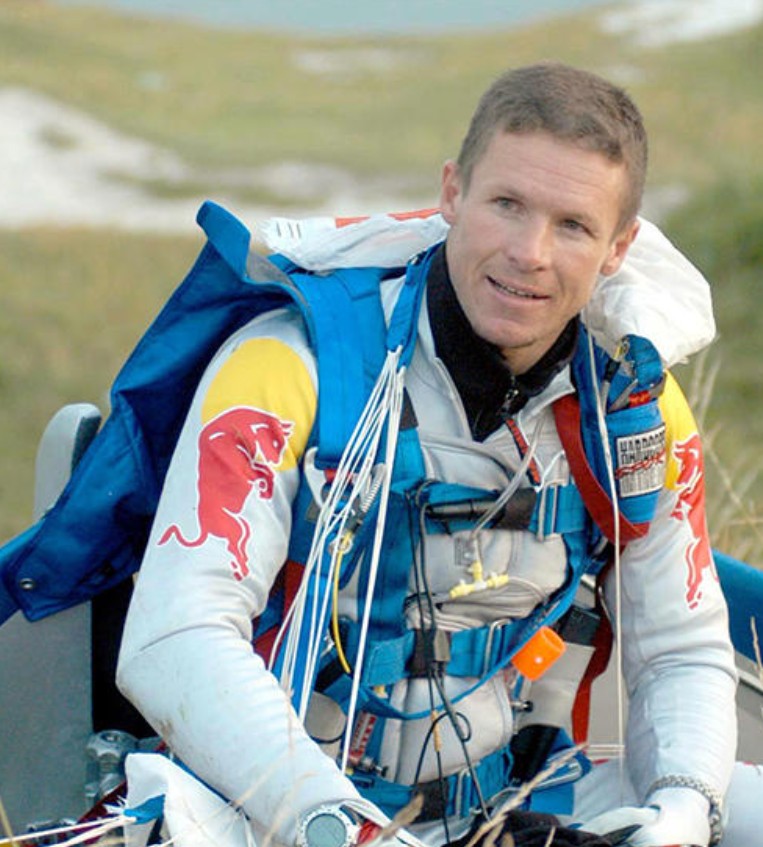Felix Baumgartner Death Video and The Fatal Crash
The world of extreme sports and aviation has lost one of its most legendary figures. Felix Baumgartner, the Austrian daredevil best known for becoming the first skydiver to break the sound barrier during his stratospheric leap in 2012, died in a tragic accident along the eastern coast of Italy. He was 56 years old.

Italian firefighters confirmed that a paraglider crashed into the side of a swimming pool in the coastal city of Porto Sant’Elpidio on Thursday, and the victim was identified as Baumgartner. The city’s mayor, Massimiliano Ciarpella, expressed the community’s grief, calling him “a figure of global prominence, a symbol of courage and passion for extreme flight.”
The news has reverberated across the globe, reminding the world of the audacious feats that made Baumgartner a household name. From daring jumps off skyscrapers to his record-shattering dive from the edge of space, “Fearless Felix” was more than an athlete he was an icon of human daring and ambition.
Contents
The Fatal Crash and Video
Baumgartner’s final flight was not from the stratosphere but from the skies above Italy. On Thursday, local emergency responders rushed to the scene after reports of a paraglider colliding with a structure near a swimming pool in Porto Sant’Elpidio. Despite their efforts, Baumgartner did not survive.
Felix Baumgartner Death Video
felix-baumgartner-death-video.mp4
The mayor’s tribute underscored the impact of his death not only on the city but also on the global community of adventurers and admirers. “Our community is deeply affected by the tragic disappearance of Felix Baumgartner,” Mayor Ciarpella wrote in a heartfelt post.
While investigations into the crash continue, the accident serves as a stark reminder of the inherent risks that come with extreme sports a risk Baumgartner had embraced throughout his career.
Legacy as “Fearless Felix”
Felix Baumgartner earned his nickname through decades of extraordinary stunts. His most defining moment came on October 14, 2012, when he leapt from a capsule suspended 24 miles above Earth, breaking the sound barrier with nothing but his body.

The jump, part of the Red Bull Stratos project, captured the world’s attention. Wearing a pressurized suit, Baumgartner stepped into the void from 39 kilometers above New Mexico. Millions watched online as he fell freely toward Earth, reaching a top speed of 843.6 mph 1.25 times the speed of sound.
The feat was not without peril. Midway through the descent, Baumgartner entered a violent flat spin while still supersonic, spinning uncontrollably for 13 seconds. His crew later revealed the danger of blacking out or suffering brain injury in such a spin. Miraculously, he stabilized and regained control, eventually deploying his parachute and landing safely in the New Mexico desert.
Speaking afterward, Baumgartner reflected on the profound experience: “When I was standing there on top of the world, you become so humble. You do not think about breaking records anymore, you do not think about gaining scientific data. The only thing you want is to come back alive.”
Breaking Records and Scientific Contribution
Baumgartner’s stratospheric leap was not only a spectacle it was also a landmark in science and exploration. His altitude shattered the previous record set in 1960 by U.S. Air Force Captain Joe Kittinger, who had jumped from 19.5 miles. Kittinger himself served as an adviser on the Red Bull Stratos mission, linking two generations of skydiving pioneers.
The data collected from the mission contributed to aerospace research, particularly in understanding high-altitude survival and the performance of pressurized suits. Baumgartner’s record for highest jump stood until 2014, when Google executive Alan Eustace surpassed it with a leap from 25.7 miles.
Still, Baumgartner’s daring achievement remains iconic because it was as much about human courage as about numbers. He demonstrated what was possible when technology, training, and raw bravery converged.
Cultural Impact and Media Attention
Few extreme sports events have captured public imagination like Baumgartner’s 2012 jump. YouTube livestreamed the mission to millions around the world, making it one of the most-watched live events in internet history at the time.
Viewers remember the moment he gave a calm thumbs-up before stepping out of his capsule. As he plummeted toward Earth, the tension was palpable. Relief and jubilation followed when his parachute deployed, and his triumphant landing cemented his status as a global hero.
The mission wasn’t just a personal achievement it became a cultural milestone. Headlines hailed him as a modern-day Icarus who had succeeded where others could not. To many, Baumgartner embodied the audacity of human exploration in the 21st century.
Career Beyond the Stratospheric Jump
While the Stratos mission defined his career, Baumgartner had long been pushing boundaries before 2012.
Military background: He served as an Austrian military parachutist, mastering the art of free fall and precision jumps.
Urban stunts: He leapt from skyscrapers, bridges, and iconic landmarks. One of his most famous urban stunts was leaping from the arm of the Christ the Redeemer statue in Brazil, a feat that captured worldwide attention.
Crossing the English Channel: In 2003, he used a custom carbon fiber wing to fly across the English Channel after being dropped from a plane, showcasing his versatility beyond traditional skydiving.
Helicopter stunt pilot: In later years, Baumgartner transitioned into aviation displays, performing breathtaking maneuvers with The Flying Bulls across Europe.
Each chapter of his career underscored a restless spirit unwilling to accept limits.
Personal Philosophy and Reflections
Baumgartner was more than a thrill-seeker; he was a philosopher of risk. After his supersonic dive, he often spoke about the unique perspective gained from extreme experiences.
On breaking the sound barrier, he admitted it was “hard to describe because you don’t feel it.” To him, the magnitude of the event was not physical but existential.
He also shared a simple but profound thought: “Sometimes we have to get really high to see how small we are.” This reflection resonated with audiences worldwide, capturing the humility that often accompanied his daring feats.
His words reflected an understanding that extreme exploration is not only about records but about gaining perspective on life and humanity’s place in the universe.
Reaction to His Death
News of Baumgartner’s passing has left the extreme sports world in mourning. Fans and colleagues alike have paid tribute to the man who expanded the limits of human possibility.
For many, the tragedy is poignant but symbolic Felix Baumgartner lived and died in pursuit of the skies. He dedicated his life to pushing boundaries, and even in death, he is remembered for his courage rather than the circumstances of his passing.
Tributes emphasize his role as an inspiration not only to athletes but also to dreamers, scientists, and innovators who saw in him a reminder that the impossible can be achieved.
Felix Baumgartner’s life was one of audacity, danger, and triumph. From his daring urban jumps to his supersonic leap from the stratosphere, he redefined what it meant to be fearless. His contributions extended beyond sport into science, culture, and inspiration for generations to come.
Though his life ended in tragedy, his legacy will endure. Baumgartner showed the world that with courage, preparation, and vision, humans can go beyond the limits of what seems possible.
In the end, Felix Baumgartner will not only be remembered as “Fearless Felix” who broke the sound barrier with his body, but as a symbol of humanity’s eternal desire to touch the skies and explore the unknown.
Daily News -Otávio Jordão da Silva Video and Mob Justice
Justin D Mohn Video and National Alarm, Political Rant
Gabriela Lima Santana Video and Chilling Case
Alejandro Gonzalez Video and Died Heroically in Cancun
Vika and Vova Jump Video and Captivated the Internet
Hugo Figueroa Shot 100 Times in Viral Video
Kaeelen Garcia Viral Video and Digital Scandal

